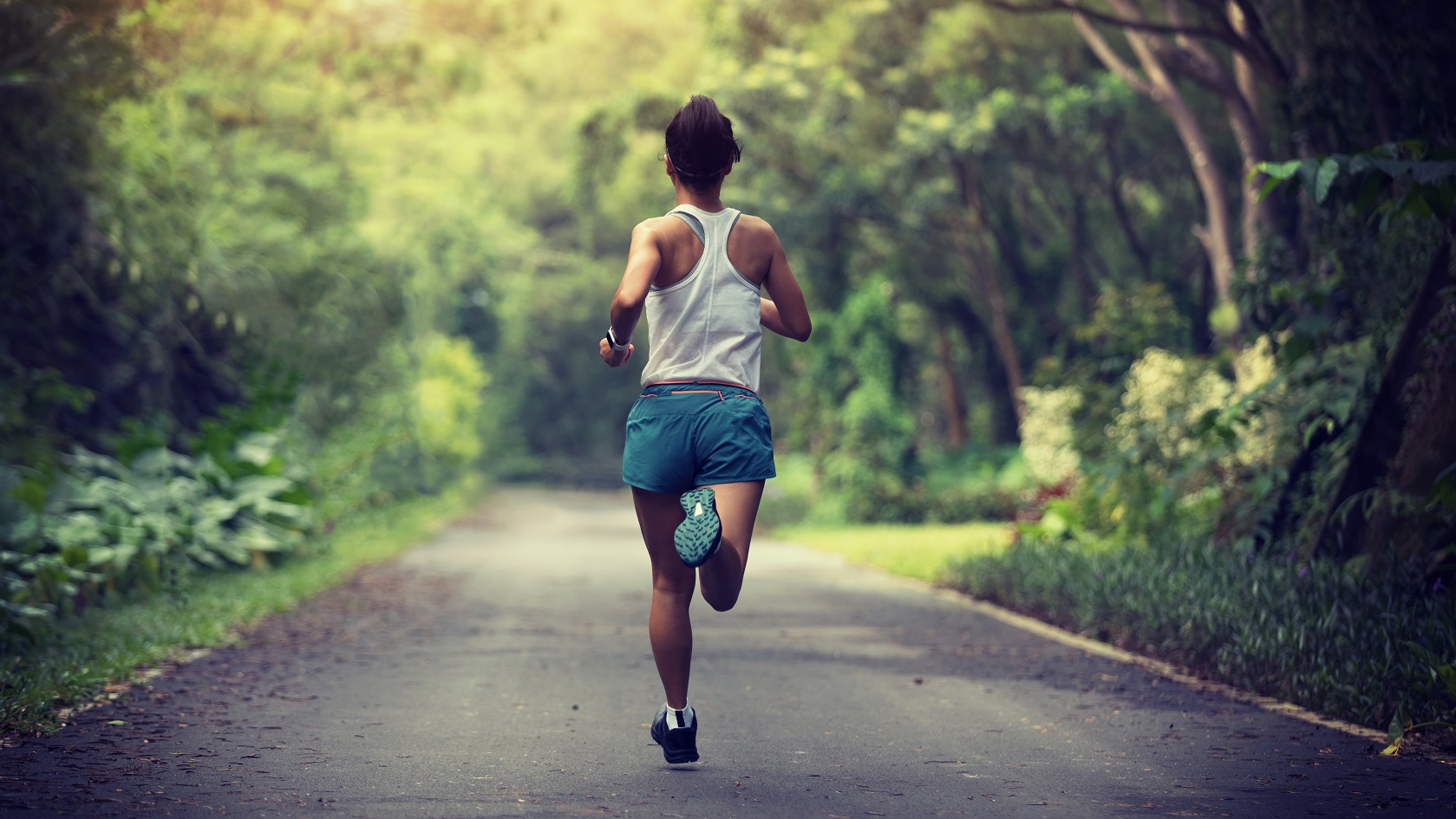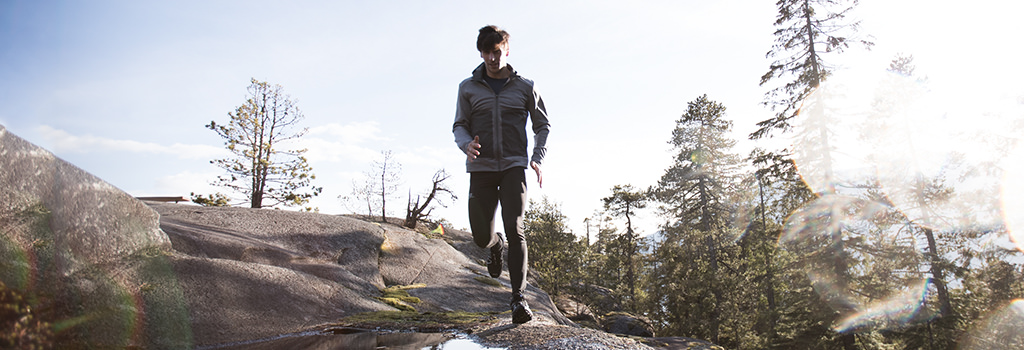Whether you’re running along towpaths, through fields, or up and down mountain trails, having durable trail running shoes with good grip is vital. Proper footwear will give you the confidence you need in your feet to stopping second-guessing your every step, helping you run faster and more efficiently. To help you tackle the toughest off-road terrain we’ve put together this guide on how to choose the best trail shoes for you.
What are Trail Running Shoes?
Trail running shoes are specifically designed to address the unique challenges faced by trail runners, setting them apart from standard road running shoes.
Trail running shoes feature:
- Deeper lugs and more aggressive tread patterns for superior grip on varied terrain, enhancing both performance and stability.
- Stiffer, tougher soles and hidden toe plates that offer increased protection, shielding your feet and toes from bruising caused by rocks, roots, and debris.
In contrast, road running shoes:
- Typically lack the necessary grip and support for rough or uneven terrain, which can increase your risk of injury if used off-road.
Additional key differences:
- Trail shoes generally have a lower heel height and heel-to-toe drop, resembling minimalist shoes. This design helps you react more quickly to changing surfaces and improves overall stability on unpredictable ground.
Overall, choosing trail running shoes over road running shoes ensures you have the grip, protection, and stability needed to tackle demanding trails safely and confidently.

How to Choose your Trail Shoes
GAIT ANALYSIS
Understanding your gait is a crucial first step in choosing the best trail running shoes. Just as with road running, knowing how your feet move and what level of support you need will help you find shoes that keep you comfortable and injury-free on the trails.
Why Gait Analysis Matters
- Gait analysis identifies your running style, specifically how much your foot rolls inward (pronation) with each step.
- If you overpronate (your foot rolls in too much), you’ll need shoes with extra support—this remains important even when running off-road.
- Matching your shoe to your gait can reduce the risk of injury and improve your running efficiency.
How Gait Analysis Works
- All Runners Need stores offer gait analysis, often using video technology to record your running on a treadmill.
- Our expert fitters analyse slow-motion footage to assess:
- The degree of pronation (neutral, overpronation, or underpronation/supination).
- Where your foot strikes the ground.
- Other factors like cadence, heel striking, and movement inefficiencies.
- Based on the analysis, they recommend the right type of shoe—neutral, stability, or support shoes—to match your needs.
Type of Trail
Understanding the type of trail you’ll be running on is essential when choosing the best trail running shoes. Once you know your gait, you can narrow down your options based on terrain and intended use.
Different Trail Types and Shoe Features
- Technical Terrain (rocky, rooty, uneven):
- Look for shoes with aggressive tread patterns and deep lugs for maximum grip.
- Stiffer soles and reinforced uppers provide protection against rocks and debris.
- Muddy or Soft Terrain:
- Opt for shoes with widely spaced, deep lugs to shed mud and prevent slipping.
- Durable, water-resistant uppers help keep feet dry and comfortable.
- Hard-packed or Dry Trails:
- Shoes with moderate lugs and cushioning are ideal for comfort and efficiency.
- Lightweight models with breathable uppers work well for less technical paths.
- Mixed or All-Terrain:
- Versatile shoes that balance grip, cushioning, and protection suit runners who encounter a variety of surfaces.
- Features like multidirectional lugs and adaptable midsoles enhance performance across changing conditions.
RACING OR SPEEDWORK
When it comes to racing or speedwork on the trails, your choice of shoe can make a significant difference in your performance. Lightweight shoes are key for these activities because they help you move faster and feel less fatigued over long distances.
What to Look For in Racing or Speedwork Trail Shoes:
- Minimal structure and support to reduce weight and increase responsiveness.
- Less built-in protection compared to everyday trail shoes, making them lighter and more agile.
- Reliable grip is still essential, so choose models with quality outsoles that provide traction on varied terrain.
- Streamlined designs that prioritise speed and efficiency over maximum cushioning or durability.
Choosing a lighter, more flexible trail shoe will help you maximise your speed and agility during races or interval sessions, while still keeping you safe on uneven ground.

MUDDY OR UNSTABLE TERRAIN
For runners tackling occasional off-road routes, recreational trails, or especially muddy paths, it’s important to choose a trail shoe that offers both stability and traction.
Key Features to Look For:
- Sturdy construction for durability and support on uneven, unstable ground.
- Deep lugs (typically 4–6 mm) to provide extra grip and prevent slipping in mud and soft terrain.
- Stiff soles to help maintain stability and protect your feet from rocks, roots, and debris.
- Outsoles designed to shed mud easily, preventing build-up and maintaining traction.
Choosing shoes with these features will help you stay secure and confident, even on the muddiest and most unstable trails.
STEEP AND DIFFICULT TERRAIN
Tackling steep and difficult terrain—such as mountain trails or steeplechase events—demands trail running shoes that prioritise both support and protection. Shoes built for these conditions are designed to keep your feet secure and stable, reducing the risk of ankle rolls and injuries on uneven ground.
Key Features for Steep and Difficult Terrain:
- Enhanced stability and structure to support your ankles and prevent rolling.
- Stiffer outsoles for extra stability on rocky and uneven surfaces.
- Reinforced uppers and protective elements (like toe guards) to shield your feet from stones, roots, and sharp debris.
- Aggressive tread patterns with deep, widely spaced lugs for reliable grip on loose, steep, or slippery ground.
- A secure fit that keeps your foot in place, minimising movement inside the shoe when navigating slopes and technical sections.
Selecting a trail shoe with these features will give you the confidence and protection needed to handle the most challenging terrain, allowing you to focus on your performance and enjoy the adventure.
Features To Look Out For...
WATERPROOF
Many trail running shoes come with waterproof features, making them a great choice for wet or unpredictable conditions.
Waterproof trail shoes typically use advanced membranes like GORE-TEX in their uppers to help keep your feet dry during rain, mud, or when splashing through puddles. These membranes block water from entering the shoe while providing some protection from cold air, making them especially useful for winter or colder climates.
Benefits of Waterproof Trail Running Shoes:
- Keep your feet dry in wet, muddy, or snowy conditions.
- Help keep your feet warmer during cold runs by trapping body heat inside the shoe.
- Often more durable than non-waterproof models, with tough uppers that resist abrasion from rocks, roots, and debris.
- Some models, like those with GORE-TEX Invisible Fit, offer a lighter, more breathable, and quicker-drying construction compared to traditional waterproof linings.
When choosing a waterproof trail running shoe, look for a fit that’s comfortable and snug, with enough protection and grip for your typical running conditions. This will help ensure your feet stay dry, warm, and protected on even the wettest trails.
PADDING
When choosing trail running shoes, padding in the collar and tongue is a small detail that can make a big difference, especially on longer runs.
A padded collar and tongue help add support and prevent rubbing, reducing the risk of blisters and discomfort over time. This is particularly important if you spend hours on the trails, as even minor irritation can become a major problem during extended efforts.
Benefits of Padding in Trail Running Shoes:
- Provides extra support around the ankle and top of the foot.
- Helps avoid rubbing and pressure points, minimising the risk of blisters.
- Enhances overall comfort, making shoes feel better straight out of the box.
- A padded tongue can also protect your instep from lace pressure, which is especially helpful if you need to tighten your shoes for a secure fit.
- Gusseted or integrated tongues and collars can further improve comfort by keeping debris out and ensuring a snug, sock-like fit.
When trying on trail running shoes, pay attention to how the collar and tongue feel against your foot. These small comfort features can have a big impact on your trail running experience, especially over longer distances.

Getting Started on Running Trails
Hitting the trails for the first time can be a little daunting so here are a few tips to help you get going
1. Take your time - If you’re new to trail running, go slowly at first to get used to placing your feet on uneven surfaces and slippery terrain. Don’t rush or you’re more likely to trip or injury yourself.
2. Notice your technique - You may even find yourself running as if you’re on egg shells, with higher knees and a faster stride turnover to stop yourself tripping on unexpected roots and stones. This is completely normal, but don’t rush, just relax into it.
3. Strength training - Make sure you add some simple strength training exercises to strengthen your legs and feet, ensuring good stability.
4. Pace yourself - Don’t go too far too fast. And don’t go too fast either. Aim to gradually build both distance and speed, even if you can already run much further on road.
5. Proper kit - As well as correct footwear you need correct running clothing. Ensure you have a good waterproof jacket and technical running socks to keep you running dry and comfortable.
Trail Running Shoes FAQs
Focus on grip, support, and protection. Choose shoes with deep lugs for muddy or technical terrain and reinforced uppers for durability. Consider cushioning based on your comfort preference and the distance you plan to run. Waterproofing is useful for wet conditions, but breathable shoes are better for hot or dry climates.
Identify your gait and any support needs - overpronators may require stability features. Runners Need stores offer gait analysis to help you find the right fit. Look for shoes that match your foot shape and running style, ensuring a snug but not tight fit for comfort and injury prevention.
Trail shoes have deeper, more aggressive tread for traction on uneven surfaces and reinforced uppers for protection against rocks and roots. Road shoes are lighter and designed for smooth, paved surfaces. Don’t use road shoes on technical trails, as they lack the necessary grip and protection.
Cushioning absorbs impact and increases comfort, especially on long runs or rough terrain. Minimalist shoes offer better ground feel but less protection, while max-cushioned models are ideal for ultramarathons or recovery runs. Most runners prefer moderate cushioning for a balance of comfort and responsiveness.
Waterproof shoes keep your feet dry in wet or muddy conditions but can be less breathable, leading to sweaty feet. Breathable shoes are lighter and cooler, making them better for warm or dry climates. Choose based on the typical weather and terrain you’ll encounter.
For muddy or technical trails, select shoes with deep, widely spaced lugs for better grip and mud shedding. Shallow lugs are suitable for hard-packed or less technical trails. Look for rubber compounds that offer traction on wet or slippery surfaces if needed.
Replace your shoes every 300–500 miles, or sooner if you notice worn-out tread or reduced cushioning. Regularly inspect your shoes for signs of wear, especially after running on rough or rocky terrain, to maintain support and prevent injuries.
Popular brands include Salomon, Hoka, Altra, Brooks, and La Sportiva. Each offers a range of models for different terrains and preferences. Try several brands to find the best fit and feel for your running style and needs.
Related Articles





